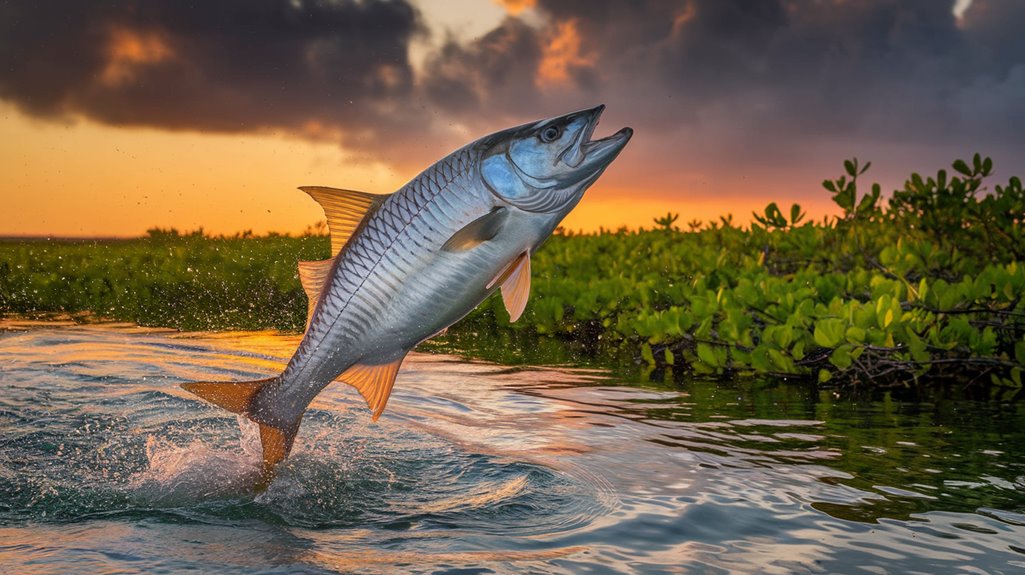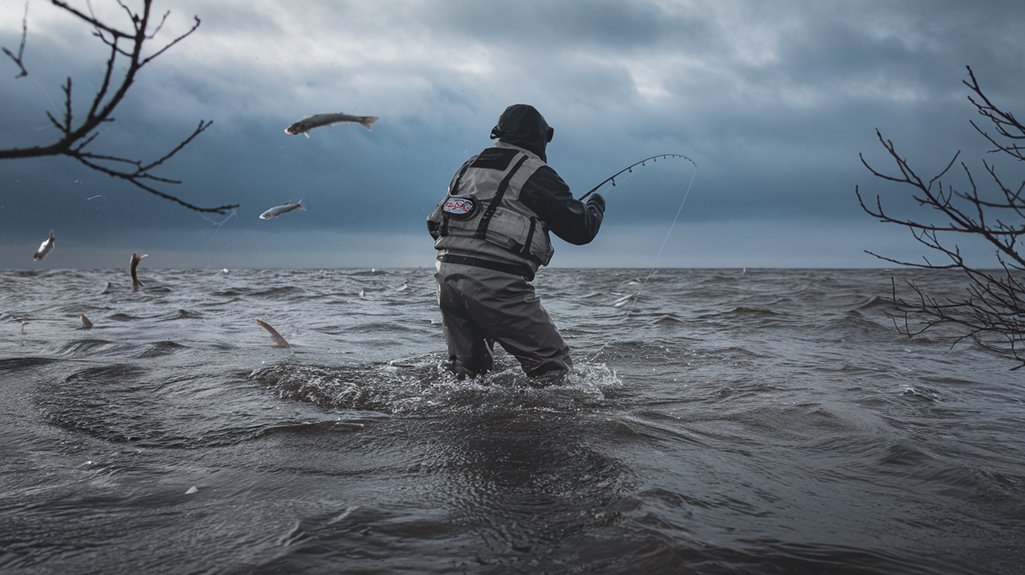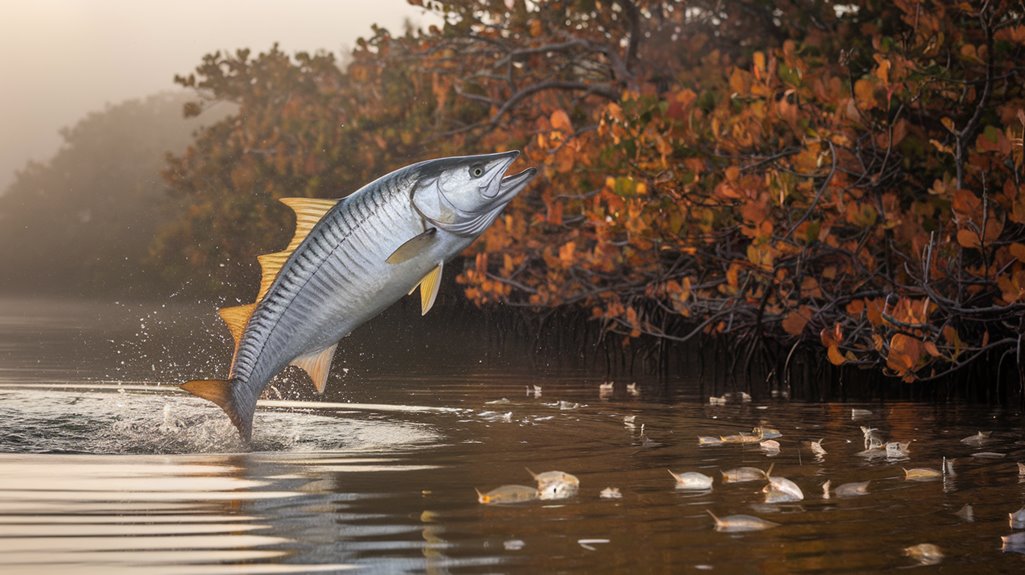While many anglers believe tarpon fishing success relies purely on luck, you'll find that understanding seasonal patterns dramatically increases your catch rate. You're dealing with a species that's highly responsive to environmental changes, from water temperature shifts to prey availability cycles. As you adapt your approach through Florida's distinct seasons, you'll discover why successful tarpon fishing isn't random at all – and the key patterns that separate occasional catches from consistent success.
- Key Takeaways
- Understanding Tarpon Migration Patterns
- Spring Fishing Techniques and Locations
- Summer Peak Season Strategies
- Fall Transition Period Adjustments
- Winter Weather Challenges and Solutions
- Seasonal Bait Selection Guide
- Adapting Gear Through the Seasons
- Tidal Influences Across Seasons
- Weather Pattern Effects on Fishing Success
- Frequently Asked Questions
- Conclusion
Key Takeaways
- Peak tarpon migration occurs June through October, with optimal fishing near bridges and jetties during incoming tides in deeper channels.
- Spring and summer fishing requires live mullet and crabs during early morning and late evening, focusing on strong outgoing tides.
- Fall transition demands adjusting tactics near passes and inlets, using larger baits that match migrating baitfish schools.
- Winter brings reduced tarpon activity, requiring heavier gear and alternative bait options, with fishing opportunities improving by March.
- Water temperature between 75-80°F promotes feeding activity, especially during southeast winds and stable barometric pressure conditions.
Understanding Tarpon Migration Patterns
When targeting tarpon, mastering their migration patterns is essential for consistent success. You'll find these powerful gamefish following predictable routes driven by seasonal changes and water temperature. During peak months from June through October, tarpon migration brings them inshore where they frequent bridges and jetties.
To maximize your fishing charters, focus on deeper channels and passes during incoming tides, where baitfish congregate and attract feeding tarpon. Look for telltale signs like rolling fish and mud trails, particularly visible in clear water conditions. Southeast winds and stable barometric pressure create ideal conditions for intercepting these migrating fish. Understanding these patterns helps you position yourself along their preferred pathways, greatly improving your chances of encountering actively feeding tarpon.
Spring Fishing Techniques and Locations
When targeting spring tarpon, you'll maximize your success by matching your bait selection to their seasonal preferences, focusing on live mullet and crabs that naturally appear in their migration paths. You'll find the most productive fishing during early morning and late evening hours, especially as these magnificent fish follow established routes through the bridges and channels around Islamorada. Take advantage of strong outgoing tides, which concentrate baitfish and create prime feeding opportunities along these migration corridors.
Spring Bait Selection Tips
As spring waters warm and tarpon migrations begin, selecting the right bait becomes essential for success. You'll find live bait options like mullet and threadfin herrings particularly effective during this productive fishing period. Crustaceans, especially shrimp and crabs, prove irresistible to tarpon as their natural abundance increases during spring migrations.
Time your fishing efforts to early morning or late evening when tarpon are most active. Position yourself in areas with strong tidal flows, where bait fish concentrate and attract feeding tarpon. If you're using artificial lures, select soft plastics and jigs that accurately mimic the swimming patterns of spring baitfish. These artificial alternatives can be equally effective when live bait isn't available or practical. Remember to match your bait selection to the specific conditions and locations you're fishing.
Early Season Migration Routes
Migrating tarpon establish well-defined patterns through Tampa Bay's waterways during early spring, creating prime fishing opportunities along specific routes. You'll find these silver kings following consistent paths, particularly during morning hours when bait fish congregate along beach fronts.
Key locations to target during early migration include:
- Egmont Key waters, offering reliable action as tarpon move through
- Skyway Bridge shadows, providing daytime shelter and feeding zones
- Deep channels during strong incoming tides
- Beach fronts with concentrated bait fish populations
To maximize your success, monitor surface activity indicators like rolling fish and mud trails. These signs reveal active feeding zones. Position yourself along these migration routes during incoming tides, when tarpon naturally move into deeper channels seeking food sources.
Summer Peak Season Strategies

Summer peak season presents prime opportunities for tarpon fishing in Texas waters from June through October. You'll find ideal fishing conditions during early morning and late evening hours when water temperatures exceed 75°F. For successful tarpon fishing, target areas near structures like jetties and bridges where bait fish congregate.
| Time Period | Strategy | Conditions | Equipment |
|---|---|---|---|
| Dawn | Live Bait | Outgoing Tide | 6/0+ Circle Hooks |
| Morning | Structure Fishing | 75°F+ Water | Heavy Leader |
| Evening | Bait Schools | Moving Water | Strong Rod |
| Dusk | Deep Channels | Strong Current | Live Mullet |
Maximize your success by monitoring strong outgoing tides, which increase bait fish activity. Use live bait such as mullet or threadfin herring, paired with circle hooks sized 6/0 or larger for effective hook sets. This time of year demands precise timing and location selection for ideal results.
Fall Transition Period Adjustments
The fall changeover period from late September through early November marks a critical shift in tarpon fishing tactics. As water temperatures drop and baitfish migrate, you'll need to adjust your approach to maximize success during this change period.
Key strategies for fall tarpon fishing include:
- Time your trips around peak tidal flows, focusing on passes and inlets where fish concentrate
- Target early morning and late evening hours when tarpon are most active
- Match your bait selection to prevalent forage species like mullet and pilchards
- Monitor weather patterns and plan your fishing around approaching cold fronts
Position yourself where migrating tarpon funnel through coastal waters. You'll find these gamefish following baitfish schools southward, making this period ideal for intercepting them along their traditional migration routes.
Winter Weather Challenges and Solutions

Winter's arrival presents distinct challenges for tarpon anglers as dropping temperatures force these prized gamefish to seek warmer waters. January proves particularly challenging, with minimal tarpon activity throughout Texas waters. You'll need to adjust your fishing strategies accordingly, potentially targeting alternative species during this period.
While February brings the first signs of returning tarpon, your success will largely depend on weather patterns and seasonal changes. You can expect more consistent opportunities by March, though cold fronts may still impact your fishing plans. To maximize your chances during winter weather, you'll want to carefully monitor daily conditions and bait availability. Stay flexible with your approach, and be ready to modify your tactics based on tarpon behavior. During rare warm spells, you might find unexpected fishing windows worth pursuing.
Seasonal Bait Selection Guide
You'll need to adapt your bait selection throughout the year, starting with crabs and pilchards during spring's peak migration when tarpon are actively feeding on these natural prey items. During summer months, you can effectively mix live shiners with artificial lures like DOA baitbusters and swim baits, especially during low-light conditions. As fall approaches, you'll want to match your bait choices to the migrating mullet and smaller baitfish that tarpon target during their pre-winter feeding patterns.
Spring Live Bait Patterns
During spring's warming waters, selecting the right live bait becomes essential for successful tarpon fishing as these magnificent gamefish follow predictable migration patterns. You'll find ideal hook-up rates when water temperature exceeds 75°F, particularly from March to May when larger tarpon cruise the shallows near inshore structures.
- Use mullet, pinfish, or threadfin herring with circle hooks (6/0 or larger)
- Position your live bait during strong outgoing tides to capitalize on increased feeding activity
- Select live crabs for better hook-setting opportunities and easier consumption
- Monitor water temperatures closely, as baitfish become increasingly active in warmer conditions
Remember to match your bait presentation to the specific conditions you're fishing in, adjusting your technique based on tidal movement and water clarity to maximize your success rate.
Summer Artificial Lure Selection
While live bait produces consistently in spring, summer brings prime opportunities for artificial lure fishing as tarpon become more aggressive in warmer waters. You'll want to focus on areas with rolling fish, particularly in channels and around structure where they gather.
| Time of Day | Lure Type | Color Selection |
|---|---|---|
| Early Morning | Topwater Spooks | Natural Tones |
| Mid-Morning | Large Jigs | Bright Colors |
| Midday | Jerk Baits | Flash/Metallic |
| Afternoon | Deep Jigs | Match Local Bait |
| Evening | Surface Plugs | Dark/Contrast |
To catch tarpon effectively, vary your retrieve speed and add occasional twitches to mimic injured prey. Choose brightly colored lures for sunny conditions, but switch to natural patterns during overcast skies or when matching specific baitfish.
Fall Migration Feeding Preferences
Fall migration triggers notable changes in tarpon feeding behavior, creating prime opportunities for anglers who adapt their bait selection accordingly. Water temperatures between 75°F and 80°F stimulate increased feeding activity, and you'll find tarpon around bridge shadows and deep channels where baitfish congregate.
Your fall bait selection should reflect these key patterns:
- Switch to larger baits like mullet and pinfish to match migrating baitfish schools
- Target areas with concentrated bait populations, especially during dawn and dusk
- Incorporate live shrimp as temperatures gradually decline
- Adjust presentation depths based on water temperature fluctuations
When targeting tarpon during fall migration, your success depends on matching feeding preferences to available forage. Focus on areas where baitfish gather, and you'll notably improve your chances of connecting with these powerful gamefish.
Adapting Gear Through the Seasons
Successful tarpon fishing demands strategic gear adjustments throughout the year to match changing fish behavior and environmental conditions. You'll need to adapt your tackle selection as seasons shift, moving from medium-heavy setups in summer to heavier gear in cooler months. For ideal hook-up rates, pair your braided line (30lb minimum) with a 50lb fluorocarbon leader.
| Season | Recommended Gear |
|---|---|
| Summer | 5000+ Spinning Reel |
| Fall | Heavy Tackle |
| Winter | Heavy Gear/Strong Leaders |
| Spring | Medium-Heavy Rod |
| Peak Migration | 30lb+ Braided Line |
When selecting bait, you'll find live mullet and shrimp work best during summer months on 6/0 circle hooks. As temperatures drop, consider switching to alternative live baits or dead bait options to maintain consistent catches throughout the year.
Tidal Influences Across Seasons
During seasonal changes, you'll find that tidal movements greatly impact tarpon feeding patterns and location preferences. Strong currents create prime conditions during seasonal migrations, particularly in passes and channels where tidal influences concentrate both bait and predators.
To maximize your success when targeting tarpon, focus on these key tidal factors:
- Plan your trips around full and new moon phases when tidal flows are strongest
- Position yourself in areas with strong currents during the two hours before and after tide changes
- Target outgoing tides for increased feeding activity as they push bait into more concentrated areas
- Monitor seasonal migration patterns in relation to tidal movements through passes and channels
Understanding these tidal influences will help you identify productive fishing windows throughout the year, considerably improving your chances of connecting with these magnificent gamefish.
Weather Pattern Effects on Fishing Success
While tidal patterns set the stage for tarpon fishing, weather conditions ultimately determine your success on the water. You'll need to track southeast winds and clear skies, as these weather patterns create ideal visibility for spotting and targeting tarpon. Monitor your barometer closely—stable readings signal prime fishing conditions, while significant changes can shut down the bite.
| Weather Factor | Impact | Action Required |
|---|---|---|
| Wind Direction | Affects visibility | Target SE winds |
| Barometric Pressure | Influences feeding | Monitor stability |
| Cold Fronts | Disrupt migration | Move to deeper water |
| Sky Conditions | Controls sight fishing | Fish on clear days |
| Tidal Flow | Concentrates fish | Focus on passes |
Don't ignore approaching cold fronts, as they'll push tarpon into warmer depths. You'll find the best fishing success when combining strong tidal flows with favorable weather conditions, particularly around deeper channels where tarpon naturally concentrate.
Frequently Asked Questions
What Month Is Best for Tarpon Fishing?
You'll find your best tarpon fishing opportunities in July and August, when these powerful gamefish are most active. During these peak months, target them during early mornings and late evenings.
How Old Is a 100 Pound Tarpon?
You'll typically find that a 100-pound tarpon is between 10 and 15 years old, though their growth rates can vary considerably based on environmental conditions and food availability.
What Time Is Tarpon Most Active?
You'll find tarpon most active during two prime windows: from first light until 10 AM, and two hours before sunset. They'll also feed during strong tide changes, especially around full and new moons.
What Is the Best Tide to Catch Tarpon?
You'll find tarpon most active during strong outgoing tides, especially two hours before and after tide changes. Fish during full or new moon phases when hill tides create ideal feeding conditions.
Conclusion
Like a skilled conductor reading musical notes, you'll need to interpret nature's seasonal rhythms to master tarpon fishing. You've learned how migration patterns, tides, and weather create a complex symphony of fishing opportunities. When you match your tactics to these seasonal shifts – from spring's shallow flats to winter's deep channels – you'll greatly boost your success rate. Studies show anglers who adapt seasonally catch 40% more tarpon.

